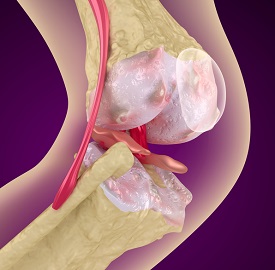Osteochondritis Dissecans Specialist in Lenoir, NC

What Is Osteochondritis Dissecans?
Osteochondritis dissecans, also called OCD, is a joint condition that occurs when there is insufficient blood flow to the joint, causing part of the bone to die and cracks to form in the bone and cartilage. Tissue often comes loose from the damaged joint, causing pain and limited joint mobility.
While anyone can develop this condition, it most commonly occurs in young athletes. If you are experiencing joint pain and are hearing a crackling sound when you move your joint, you may have osteochondritis dissecans. Fortunately, treatment like physical therapy and surgery is available in Lenoir, NC. Call (423) 482-8711 or contact Dr. Dalal Akoury online today!
Osteochondritis Dissecans Causes
The exact cause of osteochondritis dissecans in humans is unknown. However, there are several factors that may contribute to its development:
- Restriction of blood supply (ischemia), which can be caused by vascular issues like peripheral artery disease, can prevent enough blood from getting to the joint
- Repeated stress or injury to the joint, especially from playing competitive sports
- Genetic susceptibility; in rare cases, the condition is caused by a heritable mutation in a gene called ACAN
Osteochondritis Dissecans Symptoms
When a joint is deprived of sufficient blood flow, the bone in the joint dies in a process known as avascular necrosis. The dead bone tissue is reabsorbed by the body, leaving the cartilage it once supported hanging and more vulnerable to damage.
When damage to the cartilage occurs, both bone and cartilage can crack and separate from the joint, causing the main symptom of osteochondritis dissecans: joint pain, especially during physical activity or when using the joint.
Other symptoms may include:
- Swelling and tenderness around the joint
- Joint popping or locking, or a crackling sound that occurs when the joint moves
- Joint weakness or stiffness
- Decreased range of motion in the joint
Osteochondritis Dissecans Diagnosis
When diagnosing osteochondritis dissecans, a healthcare provider will likely start with a physical examination of the affected joint to check for swelling, tenderness, and/or a loose bone fragment. Your healthcare professional may also ask to see you move the joint to check your range of motion.
You may also undergo one or more scans, such as:
- An X-ray, possibly using a dye (arthrogram), to determine whether or not there are abnormalities in your joint's bones
- If the X-ray appears normal despite symptoms, an MRI or ultrasound may be used to take images of both hard and soft tissues
- A CT scan to see the bone in high detail, which may help pinpoint the location of loose bone fragments
Osteochondritis Dissecans Treatment in Lenoir
If you have osteochondritis dissecans and your healthcare provider finds a loose piece of bone in your joint, you may need treatment. Non-surgical treatment options may include rest, crutches/splints, or physical therapy. Juveniles with OCD often heal on their own due to the fact that their skeletons are still growing, but this is rarely the case for adults; OCD surgery may be required if the loose bone piece is not stable or if non-surgical treatment is not effective.
OCD Surgery
OCD surgery is often minimally invasive and done through a scope (arthroscopic). Usually, OCD surgery consists of removing the loose cartilage and bone, but newer procedures may also involve implantation of scaffolds or bone-derived stem cells to replace the lost tissue and reduce later risk of arthritis, especially in the knees. These surgeries may include:
- Osteochondral autologous transplantation (OAT): Replacement of broken fragment with patient bone and cartilage from another site
- Bone-cartilage paste graft: Application of a paste made from patient's cartilage and bone to the defect in the joint to encourage healing
- Autologous chondrocyte implantation (ACI) with bone grafting: Replacement of broken fragment with patient bone in addition to cartilage repair using patient cartilage that has been cultivated in a lab
- Osteochondral scaffolds: Placement of structures called scaffolds that mimic bone structure in the hollow left by the broken fragment
- Marrow-derived cell transplantation: Injection of concentrated bone marrow taken from the patient's hip into the defect in the joint along with patient-derived growth factors to speed healing
The particulars of surgery for osteochondritis dissecans depend on the severity of the condition; talk to your healthcare provider about what procedure is best for you.
Request Your OCD Treatment Consultation Today
While osteochondritis dissecans can be painful and inconvenient, treatment is available that can reduce your pain and restore movement to your aching joint.
For more information or to schedule an appointment with an orthopedist in Lenoir, call (423) 482-8711 or contact Dr. Dalal Akoury online.
Frequently Asked Questions
What is osteochondrosis?
The osteochondrosis family is a group of bone and joint diseases that involve decreased blood flow to bone tissue. Osteochondritis dissecans is a type of osteochondrosis caused by insufficient blood flow to a joint.
What does osteochondritis mean?
The term osteochondritis comes from Greek words for bone, cartilage, and swelling; it refers to inflammation of tissue in a joint.
What does dissecans mean?
The term dissecans comes from the Latin word for dissection and refers to the fact that osteochondritis dissecans often results in pieces of a joint breaking off.
Where in the body does osteochondritis dissecans occur?
Osteochondritis dissecans can occur in any joint in the body but is most common in the knees, elbows, and ankles.
What is osteochondritis dissecans of the ankle?
Osteochondritis dissecans of the ankle occurs when the ankle joint does not receive sufficient blood flow, causing bone in the joint to die. This leads to cracks forming in the bone and cartilage, and pieces may even break off. This can occur in any joint, not just the ankles.
Is osteochondritis dissecans a genetic disorder?
In rare cases, a heritable mutation in a gene called ACAN can cause osteochondritis dissecans.
AWAREmed Health and Wellness Resource Center
Address
1604 Lamons LaneSuite 202
Johnson City, TN 37604
(423) 482-8711
www.awaremed.com
Hours
Mon:
9:00 am - 5:00 pm
Tue:
9:00 am - 5:00 pm
Wed:
9:00 am - 5:00 pm
Thu:
9:00 am - 5:00 pm
Fri:
9:00 am - 5:00 pm


